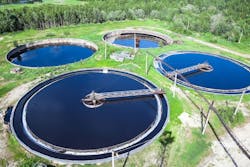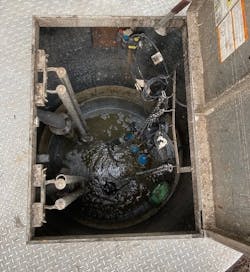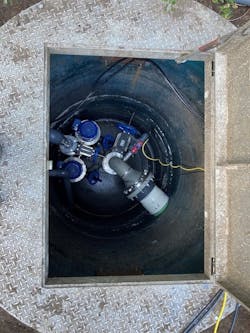Replacing a Clogged Pump Again? Solutions to Eliminate the Wet Well
James Huck is business development manager for Industrial Flow Solutions. Huck can be reached at [email protected]. Ken Patton is vice president of engineering for Industrial Flow Solutions. Patton can be reached at [email protected].
undefinedWet wells with submersible pumps have been used to manage the conveyance of wastewater since the 1950s.This method helps lift wastewater from low elevations so effluent can flow by gravity to a water treatment facility. While this design method has been embraced by users all over the world in commercial, industrial, and municipal industries, it presents challenges that require innovation for improvement.
So why is it that pumps are consistently clogging? The time and costs involved in continually repairing or replacing a clogged pump can quickly expose the difficulties created by the wet well, which can be very frustrating.
Instead of accepting these issues as "par for the course," it is important to know that creating the right system can virtually eliminate clogging issues along with the risk of flooding, contamination, and unplanned downtime.
The Perils of the Wet Well
If an operation calls for a wet well, managers know that fats, oils, greases (FOG), and fibrous debris are challenges for any submersible waste pump. It is common for these items to congeal, forming a solid layer atop the wastewater in the well. Large chunks of the solid material then break away and get sucked into the submersible pump; this is how operation-halting clogs occur.
There are even challenges that come with the basic performance of a wet well. A wet well’s operation begins when the well reaches a prescribed fill level. This requirement can create septic standing water. That wastewater can contain odors, viruses and possibly dangerous gases, putting people and the environment at risk. Furthermore, aging wet well basins run the risk of corroding, cracking, and spilling harmful contaminants into the surrounding soil or groundwater
Since the beginning, the wet well has presented perils and challenges that add to labor, cleaning, and maintenance overhead. Manually breaking up a solids layer, hiring vacuum trucks, and deploying cranes to lift the pump out of the well is messy, dangerous, and costly. Also, worker shortages have made it increasingly challenging to respond to submersible pump "high level" alarms that indicate a pump may be clogged and inoperable. Perhaps that's why so many businesses have developed an over-reliance on backup pumps and emergency storage or have chosen to repeatedly replace their clogged pumps with the least expensive models they can find.
To stop this cycle of clogging and replacing, and to eliminate the risk of a catastrophic failure that shuts down operation, managers need a pumping system engineered for the application. In return, they can rest assured that their pump will continue to operate efficiently and effectively for many years to come and reduce total cost of ownership.
Solving the Clogged Pump Challenge
Solids handling pumps are designed to handle debris in the waste stream. Organic materials, such as animal fats, skins, pits, rinds and human waste, have different properties than inorganic debris, such as wipes, feminine products, gloves, hairnets, and packaging material to name a few.
Ensuring you get the best performance and longest life from your pump requires knowing the sizes and types of debris entering your waste stream, along with your desired flow rate. The wastewater pump best suited for your application will use different impellers to prevent clogging while still running efficiently. Traditional solids handling pumps are available with three different styles of impellers, including:
- Open Vane Impeller: Liquid passes through the impeller because of centrifugal action, allowing solids and some stringy material to flow freely through the pump into the discharge line.
- Vortex Impeller: Creates a cyclonic effect on the pumped liquid, imparting energy to the liquid that forcibly pulls and discharges solids from the wet well without material contact.
- Shredding Impeller: Cuts solids into smaller pieces that are easily discharged.
Pumps having open vane impellers and vortex impellers are commonly called non-clogging pumps. They work to pass solids in their current state, compared to shredder pumps that aim to reduce the size of the materials before discharging to the force main, giving water supervisors a choice on how to handle solid collection in their system.
A lesser-known design is an open vane impeller that can also function as a shredder when operated in reverse rotation. In this design, hinged vanes fold flat, exposing shredding blades. When the torque level exceeds a threshold value, indicating a clog, the pump’s variable frequency drive reverses the direction of the impeller rotation. The sensing and shredding actions remove the clog without human intervention.
Direct In-Line Pumps Eliminate High Clean-Up Costs
Another approach to avoiding clogged pumps is direct in-line pumping. This type of pump lifts effluent at the point of entry, eliminating the need for a wet well. Without a wet well, there is no risk of FOG, wipes, and other debris separating from the pumped liquid, solidifying, and then clogging the pump. By avoiding the expense of vacuum trucks and the time spent removing material from the wet well, direct in-line pump systems help wastewater treatment operators avoid significant maintenance costs.
If a wastewater treatment plant is already using a solids handling waste pump and experiencing frequent clogging, chances are the pump is not designed for the solids that are present in the wet well. Consulting with a pump supplier and getting the right pump for the job can put an end to clogged pump troubles for good.


